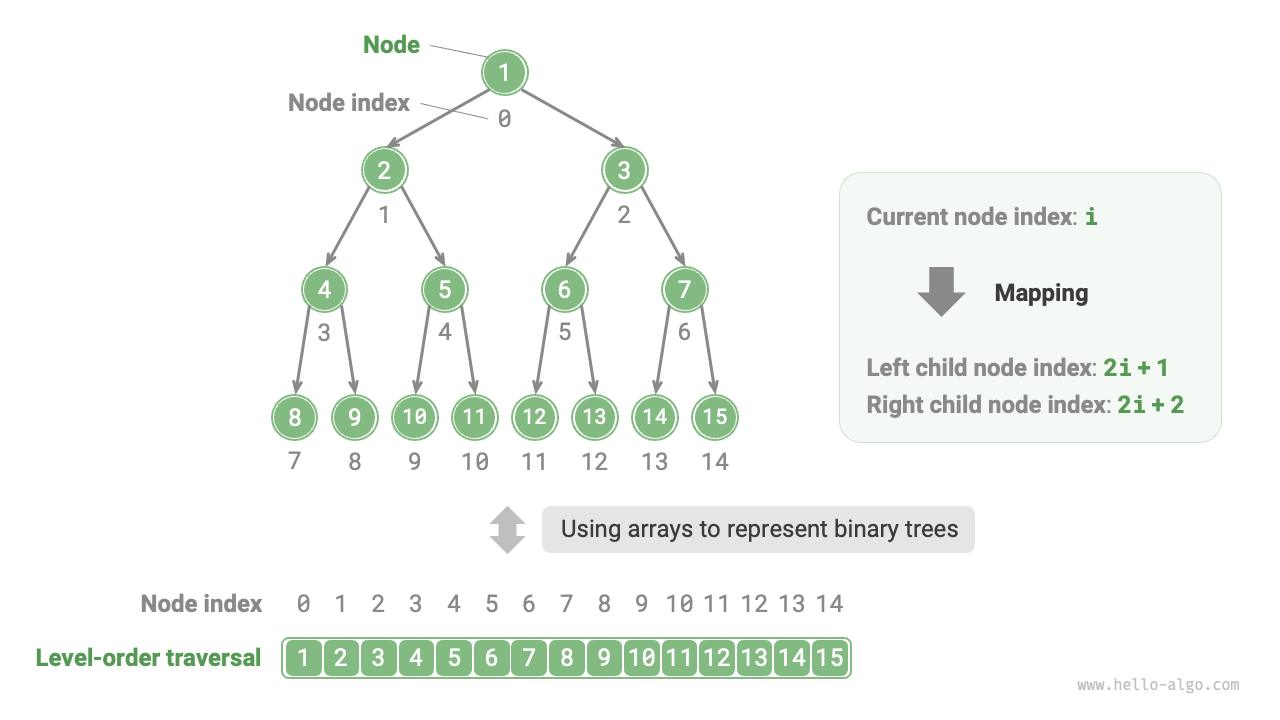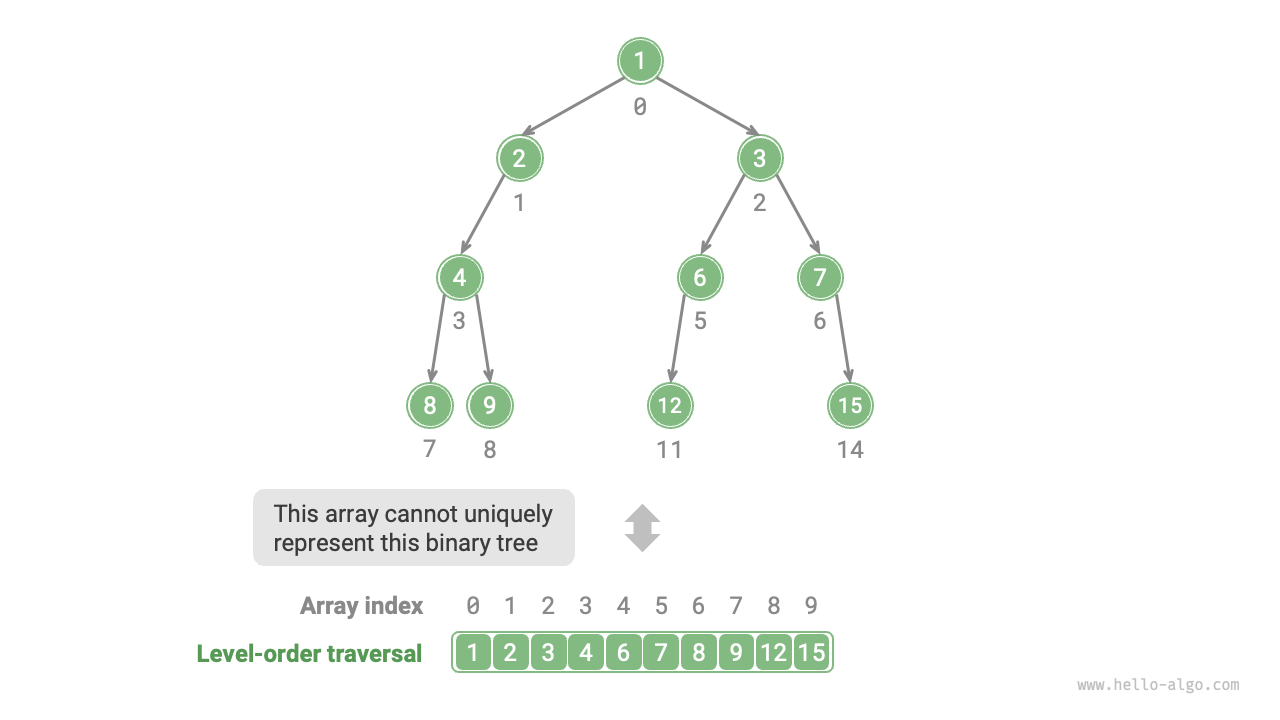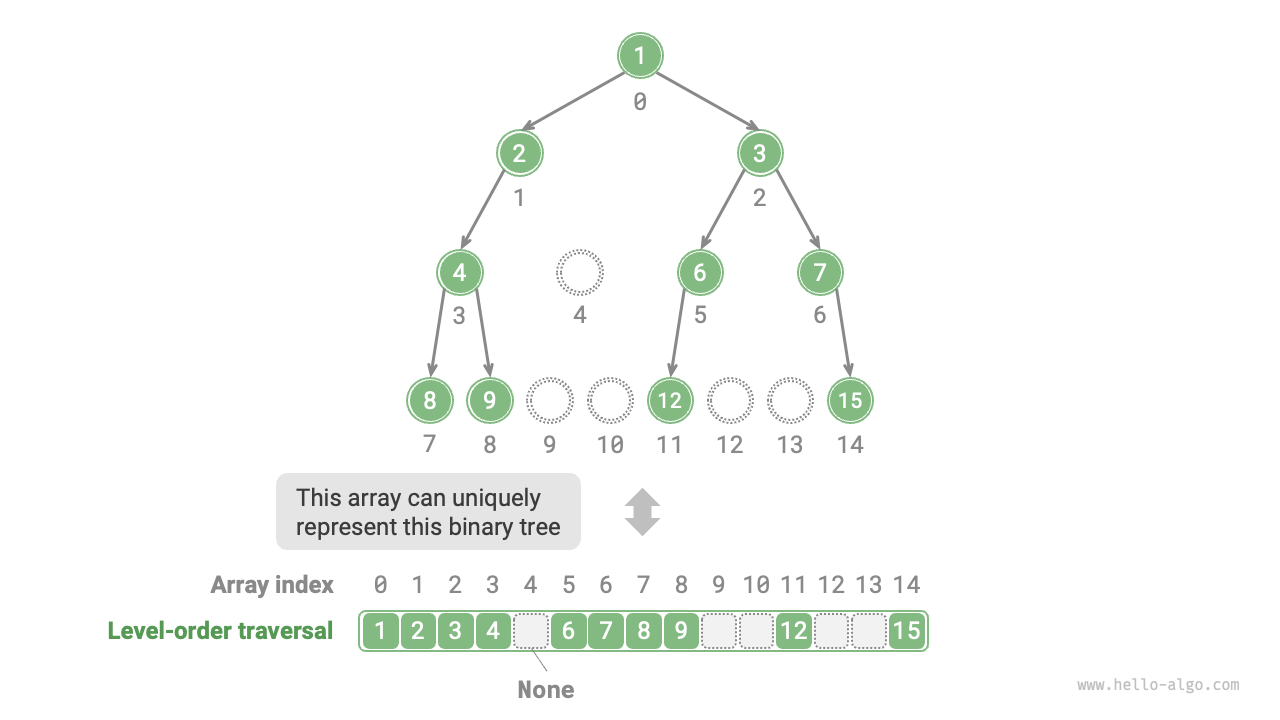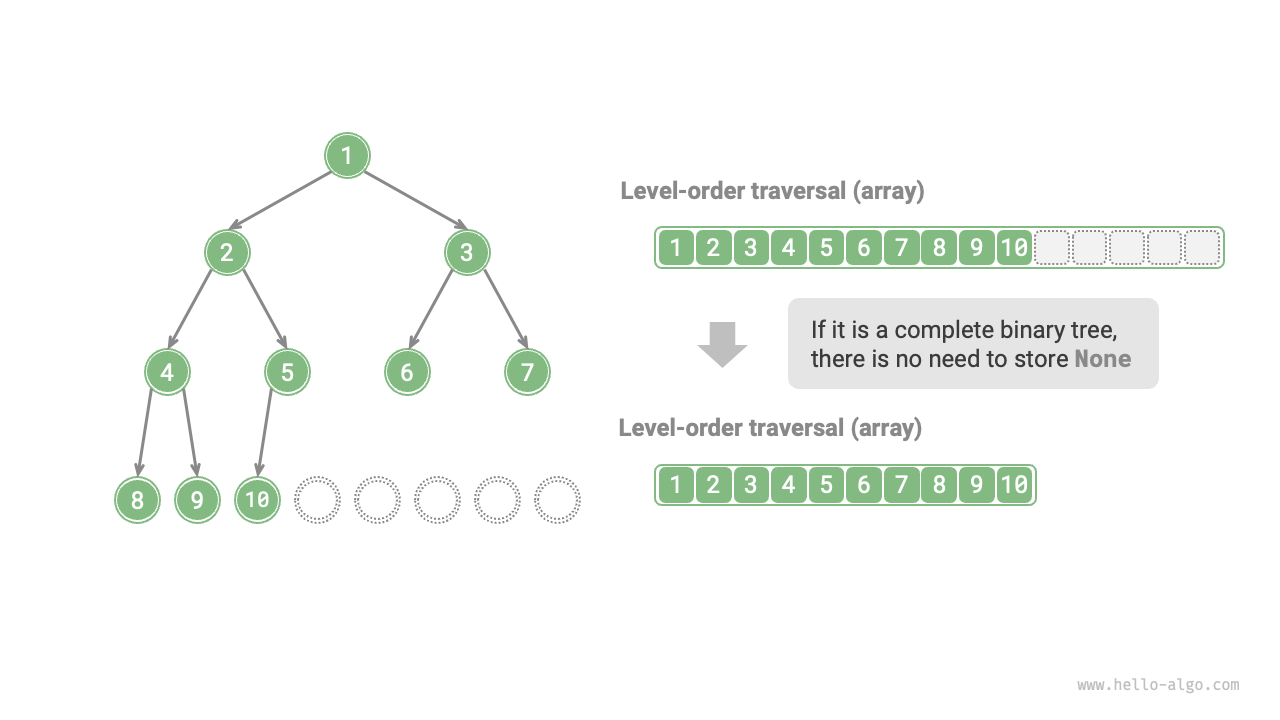7.3 Array representation of binary trees¶
Under the linked list representation, the storage unit of a binary tree is a node TreeNode, with nodes connected by pointers. The basic operations of binary trees under the linked list representation were introduced in the previous section.
So, can we use an array to represent a binary tree? The answer is yes.
7.3.1 Representing perfect binary trees¶
Let's analyze a simple case first. Given a perfect binary tree, we store all nodes in an array according to the order of level-order traversal, where each node corresponds to a unique array index.
Based on the characteristics of level-order traversal, we can deduce a "mapping formula" between the index of a parent node and its children: If a node's index is \(i\), then the index of its left child is \(2i + 1\) and the right child is \(2i + 2\). Figure 7-12 shows the mapping relationship between the indices of various nodes.
Figure 7-12 Array representation of a perfect binary tree
The mapping formula plays a role similar to the node references (pointers) in linked lists. Given any node in the array, we can access its left (right) child node using the mapping formula.
7.3.2 Representing any binary tree¶
Perfect binary trees are a special case; there are often many None values in the middle levels of a binary tree. Since the sequence of level-order traversal does not include these None values, we cannot solely rely on this sequence to deduce the number and distribution of None values. This means that multiple binary tree structures can match the same level-order traversal sequence.
As shown in Figure 7-13, given a non-perfect binary tree, the above method of array representation fails.
Figure 7-13 Level-order traversal sequence corresponds to multiple binary tree possibilities
To solve this problem, we can consider explicitly writing out all None values in the level-order traversal sequence. As shown in Figure 7-14, after this treatment, the level-order traversal sequence can uniquely represent a binary tree. Example code is as follows:
Figure 7-14 Array representation of any type of binary tree
It's worth noting that complete binary trees are very suitable for array representation. Recalling the definition of a complete binary tree, None appears only at the bottom level and towards the right, meaning all None values definitely appear at the end of the level-order traversal sequence.
This means that when using an array to represent a complete binary tree, it's possible to omit storing all None values, which is very convenient. Figure 7-15 gives an example.
Figure 7-15 Array representation of a complete binary tree
The following code implements a binary tree based on array representation, including the following operations:
- Given a node, obtain its value, left (right) child node, and parent node.
- Obtain the pre-order, in-order, post-order, and level-order traversal sequences.
class ArrayBinaryTree:
"""Array-based binary tree class"""
def __init__(self, arr: list[int | None]):
"""Constructor"""
self._tree = list(arr)
def size(self):
"""List capacity"""
return len(self._tree)
def val(self, i: int) -> int | None:
"""Get the value of the node at index i"""
# If the index is out of bounds, return None, representing a vacancy
if i < 0 or i >= self.size():
return None
return self._tree[i]
def left(self, i: int) -> int | None:
"""Get the index of the left child of the node at index i"""
return 2 * i + 1
def right(self, i: int) -> int | None:
"""Get the index of the right child of the node at index i"""
return 2 * i + 2
def parent(self, i: int) -> int | None:
"""Get the index of the parent of the node at index i"""
return (i - 1) // 2
def level_order(self) -> list[int]:
"""Level-order traversal"""
self.res = []
# Traverse array
for i in range(self.size()):
if self.val(i) is not None:
self.res.append(self.val(i))
return self.res
def dfs(self, i: int, order: str):
"""Depth-first traversal"""
if self.val(i) is None:
return
# Pre-order traversal
if order == "pre":
self.res.append(self.val(i))
self.dfs(self.left(i), order)
# In-order traversal
if order == "in":
self.res.append(self.val(i))
self.dfs(self.right(i), order)
# Post-order traversal
if order == "post":
self.res.append(self.val(i))
def pre_order(self) -> list[int]:
"""Pre-order traversal"""
self.res = []
self.dfs(0, order="pre")
return self.res
def in_order(self) -> list[int]:
"""In-order traversal"""
self.res = []
self.dfs(0, order="in")
return self.res
def post_order(self) -> list[int]:
"""Post-order traversal"""
self.res = []
self.dfs(0, order="post")
return self.res
/* Array-based binary tree class */
class ArrayBinaryTree {
public:
/* Constructor */
ArrayBinaryTree(vector<int> arr) {
tree = arr;
}
/* List capacity */
int size() {
return tree.size();
}
/* Get the value of the node at index i */
int val(int i) {
// If index is out of bounds, return INT_MAX, representing a null
if (i < 0 || i >= size())
return INT_MAX;
return tree[i];
}
/* Get the index of the left child of the node at index i */
int left(int i) {
return 2 * i + 1;
}
/* Get the index of the right child of the node at index i */
int right(int i) {
return 2 * i + 2;
}
/* Get the index of the parent of the node at index i */
int parent(int i) {
return (i - 1) / 2;
}
/* Level-order traversal */
vector<int> levelOrder() {
vector<int> res;
// Traverse array
for (int i = 0; i < size(); i++) {
if (val(i) != INT_MAX)
res.push_back(val(i));
}
return res;
}
/* Pre-order traversal */
vector<int> preOrder() {
vector<int> res;
dfs(0, "pre", res);
return res;
}
/* In-order traversal */
vector<int> inOrder() {
vector<int> res;
dfs(0, "in", res);
return res;
}
/* Post-order traversal */
vector<int> postOrder() {
vector<int> res;
dfs(0, "post", res);
return res;
}
private:
vector<int> tree;
/* Depth-first traversal */
void dfs(int i, string order, vector<int> &res) {
// If it is an empty spot, return
if (val(i) == INT_MAX)
return;
// Pre-order traversal
if (order == "pre")
res.push_back(val(i));
dfs(left(i), order, res);
// In-order traversal
if (order == "in")
res.push_back(val(i));
dfs(right(i), order, res);
// Post-order traversal
if (order == "post")
res.push_back(val(i));
}
};
/* Array-based binary tree class */
class ArrayBinaryTree {
private List<Integer> tree;
/* Constructor */
public ArrayBinaryTree(List<Integer> arr) {
tree = new ArrayList<>(arr);
}
/* List capacity */
public int size() {
return tree.size();
}
/* Get the value of the node at index i */
public Integer val(int i) {
// If the index is out of bounds, return null, representing an empty spot
if (i < 0 || i >= size())
return null;
return tree.get(i);
}
/* Get the index of the left child of the node at index i */
public Integer left(int i) {
return 2 * i + 1;
}
/* Get the index of the right child of the node at index i */
public Integer right(int i) {
return 2 * i + 2;
}
/* Get the index of the parent of the node at index i */
public Integer parent(int i) {
return (i - 1) / 2;
}
/* Level-order traversal */
public List<Integer> levelOrder() {
List<Integer> res = new ArrayList<>();
// Traverse array
for (int i = 0; i < size(); i++) {
if (val(i) != null)
res.add(val(i));
}
return res;
}
/* Depth-first traversal */
private void dfs(Integer i, String order, List<Integer> res) {
// If it is an empty spot, return
if (val(i) == null)
return;
// Pre-order traversal
if ("pre".equals(order))
res.add(val(i));
dfs(left(i), order, res);
// In-order traversal
if ("in".equals(order))
res.add(val(i));
dfs(right(i), order, res);
// Post-order traversal
if ("post".equals(order))
res.add(val(i));
}
/* Pre-order traversal */
public List<Integer> preOrder() {
List<Integer> res = new ArrayList<>();
dfs(0, "pre", res);
return res;
}
/* In-order traversal */
public List<Integer> inOrder() {
List<Integer> res = new ArrayList<>();
dfs(0, "in", res);
return res;
}
/* Post-order traversal */
public List<Integer> postOrder() {
List<Integer> res = new ArrayList<>();
dfs(0, "post", res);
return res;
}
}
7.3.3 Advantages and limitations¶
The array representation of binary trees has the following advantages:
- Arrays are stored in contiguous memory spaces, which is cache-friendly and allows for faster access and traversal.
- It does not require storing pointers, which saves space.
- It allows random access to nodes.
However, the array representation also has some limitations:
- Array storage requires contiguous memory space, so it is not suitable for storing trees with a large amount of data.
- Adding or deleting nodes requires array insertion and deletion operations, which are less efficient.
- When there are many
Nonevalues in the binary tree, the proportion of node data contained in the array is low, leading to lower space utilization.



